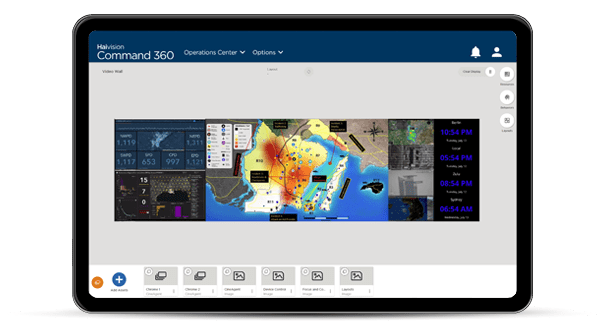There are few commercial environments in which the individual consumer is more aware of and personally affected by security protocols than at the airport. The September 11, 2001 airline hijackings and related deaths raised the collective consciousness of travelers and carriers alike concerning secure airport operations. The dramatic change in commercial airline travel which followed persists, perhaps more so, twenty years later. Security technology has evolved in that time to address heightened protocols. Airport operations centers now rely on multiple hubs specializing in different facets of communications and monitoring. Visual intelligence and collaboration platforms optimize operations by integrating these functions to form a unified common operating picture.
Airport Operations Center (AOC) Critical Functions
Among many other interesting airport statistics, the geographic footprints of the world’s largest airports are hard to fully grasp. Some airports even have their own postal zip code. It’s easy to imagine why multiple security and communication hubs are necessary, and why they all need collaborative capabilities. The critical functions listed below are common to many airport operations but vary depending on airport size and regulatory requirements based on domestic or international locations.
Public Safety Answering Points
Public Safety Answering Points, or PSAPs, serve as a point through which emergency communications are received and processed, or re-routed if necessary. A 911 center is the most common PSAP in or outside of an airport. All PSAPs rely on specialized software to improve communication management and response times. In an airport, a PSAP may encompass numerous public safety functions, including:
- Police monitoring, dispatch, and traffic
- Fire department monitoring, dispatch, and traffic
- Crash alarms
- Airport paging and announcements
- Air traffic control tower hotline
- Aviation Security (AVSEC) Operations Center
TSA-regulated airports govern security operations under a regulatory code outlining requirements for security related areas. More than just a passenger screening checkpoint, ‘security related areas’ and associated requirements often overlap with each other and include:
- Secured Area: aircraft gates and apron, baggage loading, and bag make-up room
- Air Operations Area (AOA): Runways and taxiways and general aviation area
- Security Identification Display Area (SIDA): Aircraft gates and aprons, runways and taxiways, air cargo and baggage loading, and baggage make-up room (cart and container areas for manual and automated staging)
- Sterile Area: Begins after screening checkpoints and extends to Secured Area and/or SIDA
- Airport Tenant Security Program (ATSP) Area: Any areas leased by tenants within the airport operator’s secured area
Each of these areas incorporates a variety of devices, applications, and processes, some of which dovetail communication management. Airport Security Ops utilize CCTV monitoring for video surveillance, facility and perimeter security, asset protection, cybersecurity, police department coordination and support, and event reporting.
Emergency Operations Center (EOC)
Much like the EOCs which serve municipal communities, airport EOCs monitor real-time threat conditions and respond accordingly. Emergency conditions at airports may arise due to mechanical aircraft failure, terrorist activity, HazMat event, or inclement weather conditions such as storms, hurricanes, earthquakes, etc.
Although every operations function within an airport needs integrated collaboration capabilities, an EOC relies on immediate coordination and communication due to the nature of their “mission” and natural volume of active emergency participants on-site:
- Airport police and fire departments
- Facilities and maintenance
- General operation
- Communication operations
- Security operations
- Ground crews
- Ground transportation
- Gate management
…and off-site:
- Federal agencies (TSA, FAA, DHS, FBI, FEMA, National Guard, etc.)
- Local municipal police and fire departments
- SWAT and hostage rescue/negotiator teams
- Counter terrorism
- Public and media relations
Visual Intelligence and Collaboration for AOCs
An AOC is designed to improve collaborative decision making for operators amid the controlled chaos of an airport. By managing all stages of communication and threat control, the AOC enables all secondary security ops within the airport such as securing digital and physical assets, raising situational awareness, and safeguarding personnel. Accomplishing these objectives requires a state-of-the-art visual intelligence and collaboration platform. The complexity of such a system is hard to properly address in a short blog article. There are some key concepts to consider, however, before designing or upgrading the technological nerve center of an AOC.
Dynamic Content Management
A powerful content management system allows airport operations to maintain situational awareness among multiple locations. The operators’ experience must incorporate the following:
- Simplified user controls
- Execution of multiple operating systems
- Browser-based interface
- Intuitive operation
- Centralized device management
- Instant organization, placement, and interactive control of assets
- Ease-of-use regardless of technical background
Secure, Scalable, Resilient Processing
AOCs operate 24/7/365. Any visual intelligence system must be resilient, secure, and scalable for multi-location reach. This provides simultaneous consumption of information across specialized airport functions. A fully integrated visual collaboration platform can maintain secure functionality during a crisis. High-performance, supply-chain controlled components ensure resiliency throughout an intensive system life cycle. Scalability accommodates growing technical or geographic demand with minimal reconfiguration.
Haivision has an extensive history in providing dynamic visual intelligence systems for a broad range of mission-critical operations, such as airport operations centers, around the world. Our innovative products lead the industry in ease-of-use, secure operation, and quality performance, meeting all the standards listed above and more. Contact us today for a demo of how we can optimize your AOC visual intelligence platform.
